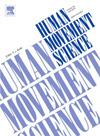当前馈和反馈过程同时发生时,阻塞与试验交错情境下感觉不确定性的差异影响
IF 1.9
3区 心理学
Q4 NEUROSCIENCES
引用次数: 0
摘要
人类运动学习理论通常假设,运动计划根据运动错误而调整的程度,与运动成功所收到的感官反馈的精度有关。然而,对这些模型的支持主要来自实验,这些实验限制了在正在进行的运动中可能发生的修正量。相反,我们最近的研究表明,当这一限制被放宽时,运动内和运动间的修正同时发生,运动计划会经历巨大而突然的变化,这种变化与先前试验中存在的感觉不确定性程度密切相关,并且对所经历的运动误差的大小和方向不敏感。在这里,我们表明,只有当不同水平的感觉不确定性在逐个试验的基础上伪随机交错时,才会观察到这些突变和错误不敏感变化的存在,而当感觉不确定性水平在试验块之间变化时则不存在。这些结果表明,运动内纠正和运动间纠正的共同发生并不是我们早期研究中挑战不确定性下传统运动学习模型的唯一重要方面。本文章由计算机程序翻译,如有差异,请以英文原文为准。
Differential impact of sensory uncertainty in blocked versus trial-interleaved contexts when feedforward and feedback processes co-occur
Theories of human motor learning commonly assume that the degree to which movement plans are adjusted in response to movement errors scales with the precision of sensory feedback received regarding their success. However, support for such models has mainly come from experiments that limit the amount of correction that can occur within an ongoing movement. In contrast, we have recently shown that when this restriction is relaxed, and both within-movement and between-movement corrections co-occur, movement plans undergo large and abrupt changes that are strongly correlated with the degree of sensory uncertainty present on the previous trial and are insensitive to the magnitude and direction of the experienced movement error. Here, we show that the presence of these abrupt and error-insensitive changes are only observed when different levels of sensory uncertainty are interleaved pseudo-randomly on a trial-by-trial basis, and are absent when sensory uncertainty levels vary across blocks of trials. These results suggest that the co-occurrence of within-movement and between-movement corrections is not the only important aspect of our earlier study that challenged traditional models of motor learning under uncertainty.
求助全文
通过发布文献求助,成功后即可免费获取论文全文。
去求助
来源期刊

Human Movement Science
医学-神经科学
CiteScore
3.80
自引率
4.80%
发文量
89
审稿时长
42 days
期刊介绍:
Human Movement Science provides a medium for publishing disciplinary and multidisciplinary studies on human movement. It brings together psychological, biomechanical and neurophysiological research on the control, organization and learning of human movement, including the perceptual support of movement. The overarching goal of the journal is to publish articles that help advance theoretical understanding of the control and organization of human movement, as well as changes therein as a function of development, learning and rehabilitation. The nature of the research reported may vary from fundamental theoretical or empirical studies to more applied studies in the fields of, for example, sport, dance and rehabilitation with the proviso that all studies have a distinct theoretical bearing. Also, reviews and meta-studies advancing the understanding of human movement are welcome.
These aims and scope imply that purely descriptive studies are not acceptable, while methodological articles are only acceptable if the methodology in question opens up new vistas in understanding the control and organization of human movement. The same holds for articles on exercise physiology, which in general are not supported, unless they speak to the control and organization of human movement. In general, it is required that the theoretical message of articles published in Human Movement Science is, to a certain extent, innovative and not dismissible as just "more of the same."
 求助内容:
求助内容: 应助结果提醒方式:
应助结果提醒方式:


